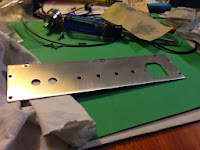I have most of the amp put together, at least roughly. At this point I'm just waiting on my output transformers to arrive. I bought them from Edcor, a company in New Mexico that makes them to order so it can take 5-6 weeks.
 Here's a picture with the tubes in place temporarily. I bought all JJ Electronics tubes because they were relatively inexpensive. For tube-people who want to know, the amp uses: GZ34S rectifier, ECC81 preamp, and EL34 output tubes (matched pair). JJ was a subsidiary of TESLA, a company with a long history in former Czechoslovakia, named after the famous engineer and physicist Nikola Tesla. When I started this project I thought it might be neat to get all parts made in the USA or something like that, but it seemed hard to find tubes made in USA now unless they are vintage. So I have an Allied (Hammond) power transformer made in Canada, Edcor output transformers from New Mexico, tubes from Slovak Republic, PCB from an engineer in Florida, miscellaneous passive components from who-knows-where, and the run capacitor I think was assembled in Mexico.
Here's a picture with the tubes in place temporarily. I bought all JJ Electronics tubes because they were relatively inexpensive. For tube-people who want to know, the amp uses: GZ34S rectifier, ECC81 preamp, and EL34 output tubes (matched pair). JJ was a subsidiary of TESLA, a company with a long history in former Czechoslovakia, named after the famous engineer and physicist Nikola Tesla. When I started this project I thought it might be neat to get all parts made in the USA or something like that, but it seemed hard to find tubes made in USA now unless they are vintage. So I have an Allied (Hammond) power transformer made in Canada, Edcor output transformers from New Mexico, tubes from Slovak Republic, PCB from an engineer in Florida, miscellaneous passive components from who-knows-where, and the run capacitor I think was assembled in Mexico.
I got only a medium sized run capacitor--apparently this is an inexpensive way to get a film capacitor which works well on an amplifier. It's oil-filled I guess for cooling. These are normally found in automotive or HVAC applications, so they are easy to find. I could have bought a 100uF capacitor but it would be bigger and in my opinion, ugly sticking up so high, so I got one that is 45uF. I'm not trying to build an ultimate stereophile amplifier, just one that sounds pretty good. I also didn't like the look of a run capacitor mounting bracket so I superglued it to the top panel. Wouldn't survive a big bump or hit, but neither would the tubes, right?
At this point, I'm still thinking the design of the amplifier is a bit plain--it's a wood box with aluminum panels, a switch and a knob. It needs some sort of character or artwork. Part of me wants to make up a logo to put on it--is that a function of my expectations that all good products are branded with a commercial name? I'll keep thinking on this and maybe come up with something to add a unique element. The output transformers will be painted blue (Edcor design) which I'm wondering if it will look either good or strange. We'll see...









